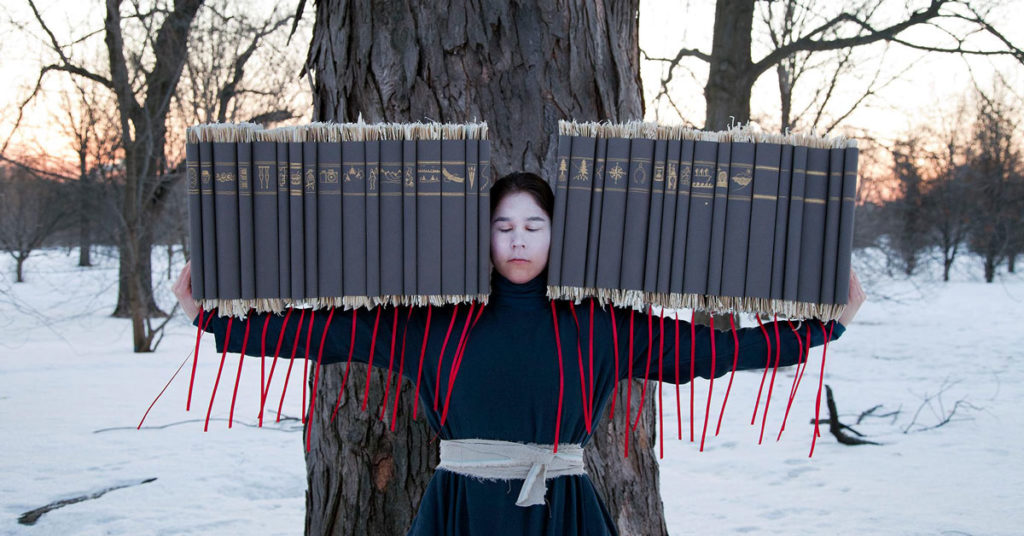“I’ve been coming to a realization about the self and identity and how everyone explores that about themselves throughout their lives,” says McMaster. “Wandering talks about going into the unknown and how that is a metaphor for life. I was thinking about my own heritage and where I’ve come from. A lot of times in life, we are not necessarily held back but our dreams, our past and our circumstances are tethered.”
This “tethering” becomes a literal motif throughout the works with the use of red thread, which represents a connection between McMaster’s past and future. In some of the images she drags and pulls on it and the violent flash of red stands out in the winter landscapes and connects the pictures as if tracing a trail through the Minotaur’s labyrinth. In Under the Infinite Sky, McMaster stares into bowls of bright blue water on the ground, intimately connecting both the sky and water through reflection. In Time’s Gravity she holds a library of annotated books the length of her arms, the red placeholders hanging down like the fringes of Cree dress. In this fantasy world, McMaster purposefully blurs the separation of human and animal by painting birds, bees and forest creatures as extensions of her own body. These shamanistic inventions reflect the ecocentrism at the core of many Indigenous values, but can also be understood as an embodiment of a more childlike innocence.
“We can always come back home in some way, but throughout life we wander and explore more about ourselves, our surroundings and other people. I wanted to remind people that when you are a kid there is that feeling of having no restrictions. So much possibility about what you might become and who you might be.”
In addition to the photographic body of work, McMaster also collaborated with performance artist Johannes Zits on Wandering Together, which brought the performative element of her photographic work out of its frames and into Katzman’s gallery space. This was McMaster’s first collaboration with another artist, and witnessing Zits bring the photographs to life brought excitement to the project. “Johannes’s work deals a lot with landscape and the body and slowly over the year we talked back and forth about what we could do together. There was this connection to the ‘wandering line.’ In previous work I had asked friends to do blind-contour drawings and so Johannes drew a line drawing of me and my body and then I took this line drawing and drew it back on him. There was this changing hands of the drawing: my presence within this performance piece was my drawing on him.” The remnants of the performance, including a sand drawing made by Zits’s body on the floor and a large sculptural tree wrapped in fabric and red ribbon complete with birds peering down from branches, sat comfortably among the photographs and acted as a bridge between reality and McMaster’s liminal fantasy.
McMaster usually stages her images within natural landscapes, so a recent month-long residency in urban Detroit as a part of the Canadian Residency was a bit of a departure. Although she was unfamiliar with Detroit, she admits that her preconceptions were not entirely positive. Detroit’s bankruptcy has given the city a certain reputation, one McMaster realized the city doesn’t deserve. “It is really beautiful here,” she says. “There are more artists and more musicians coming back to the city, moving away from bigger cities like New York and Chicago. The sense of community is more visible in Detroit; it’s kind of refreshing in that sense. Maybe it’s because I’m in a new place and because I’m young, but I want to hear the story and to get to know a community.”
Peter Rozek established the Canadian Residency to foster cross-border discussion and alter Canadians’ perceptions of Detroit. In the two years since its inception, it has hosted Canadian artists including Shary Boyle, Suzy Lake and Daniel Barrow. As a border-region, Detroit makes a fitting place for McMaster to work. Although it usually takes her a couple of years to realise a new series, she notes that Detroit has given her a lot of creative energy and a start on her next project.
“I was interested here in the Great Lakes, this place that the US and Canada share. I love water and was thinking about migration as well: the activity of Aboriginal peoples back during the time that it was being settled. So there is definitely inspiration from being in Detroit. Just coming off of this new body of work I am kind of looking into and thinking about now what I want to talk about next.”

 Meryl McMaster’s Gravity (2015) is part of the exhibition “Coyote School” opening at the McMaster Museum of Art on June 8. Image from the collection of the Doris McCarthy Gallery at the University of Scarborough.
Meryl McMaster’s Gravity (2015) is part of the exhibition “Coyote School” opening at the McMaster Museum of Art on June 8. Image from the collection of the Doris McCarthy Gallery at the University of Scarborough.







